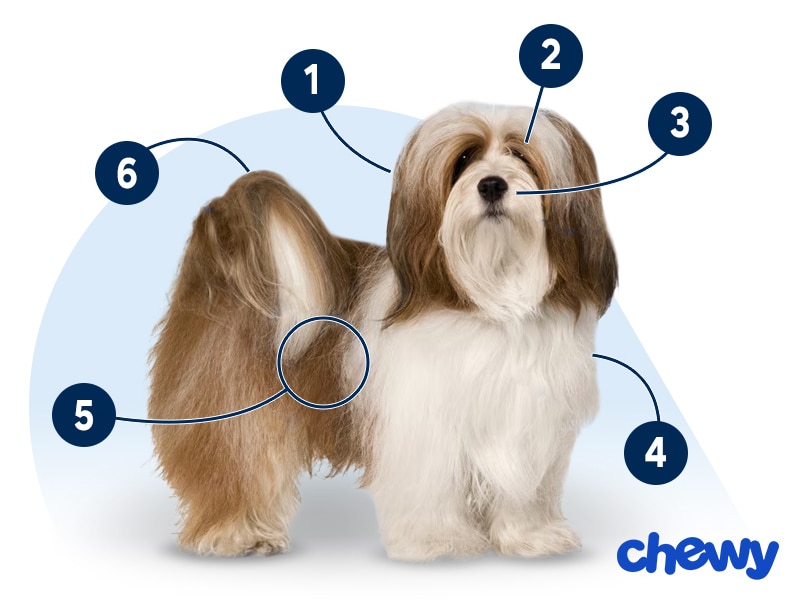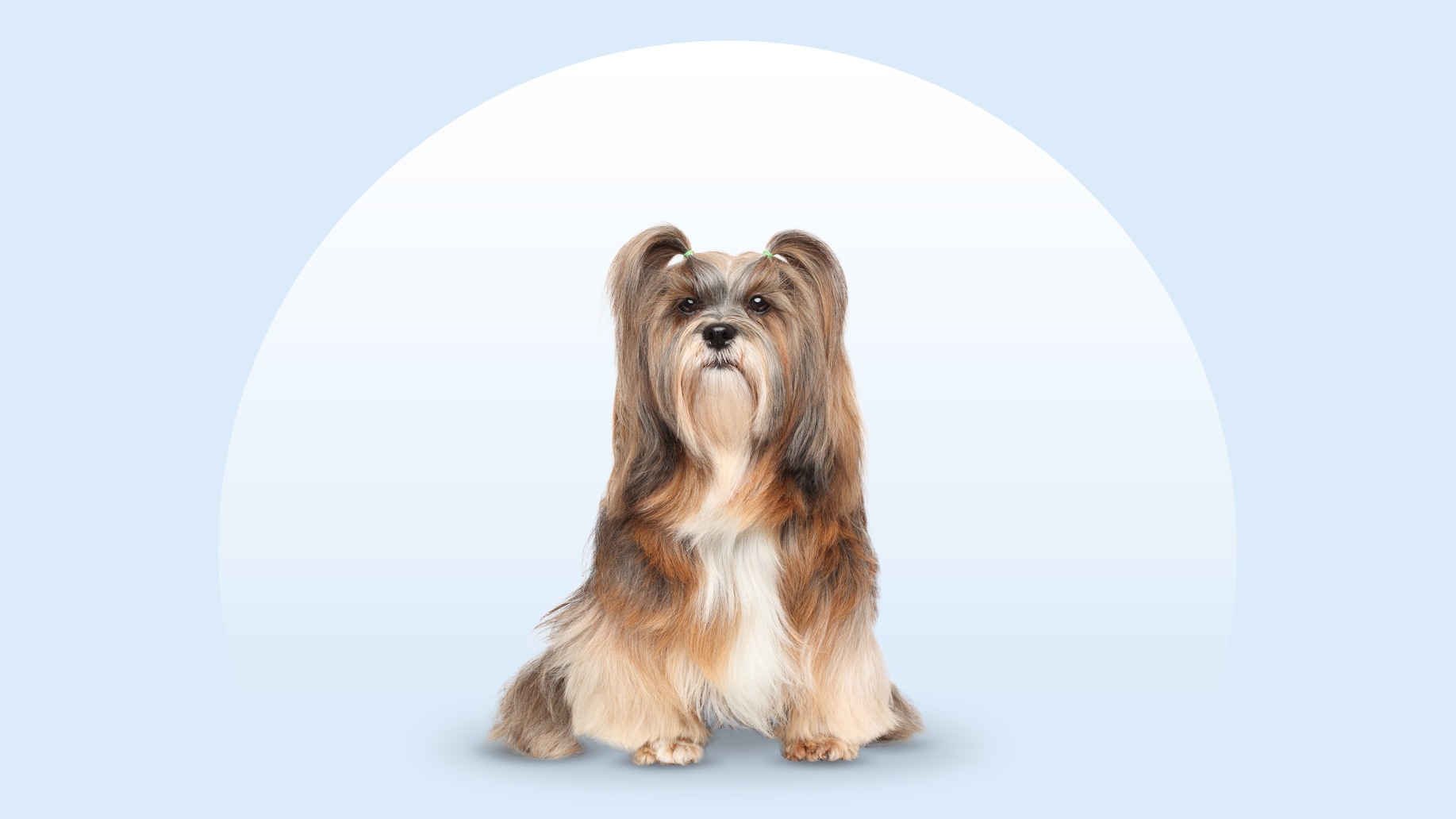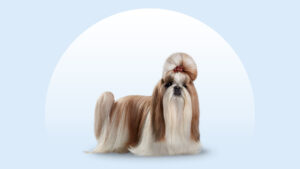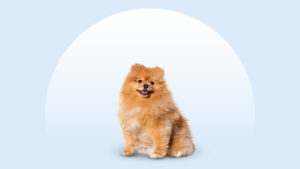Lhasa Apso
Updated October 23, 2025
Lhasa Apso
Updated October 23, 2025
The noble and charming Lhasa Apso is a clever companion with a mind of their own. But they’re also hopelessly loyal to their people, and if you’re lucky enough for them to choose you, you’ll have a devoted bestie for life. Just make sure you keep up with their extensive grooming needs!
Bright, Loyal, Playful
12–18 pounds
10–11 inches
12–15 years
Black, Cream, Golden, Grizzle, Red, White
The dignified Lhasa Apso may be the perfect lap dog today, but they once marched the halls of palaces and holy places, keeping watch over what happened inside.
Lhasa Apsos fondly recall how they were respected and adored—they’re named for the most sacred city in Tibet, after all. So, naturally, they expect that level of respect from their present-day admirers.
But their demands aren’t unreasonable—just a few treats now and then, a cozy lap to curl up in, and their favorite person at their beck and call. It’s a rough job being adorable, but Lhasa Apsos are more than happy to fulfill the role.
Lhasa Apso Characteristics
Lhasa Apso Appearance
The Lhasa Apso may be a small dog, but they’re hard to miss. With their characteristically long hair, button nose, and cute underbite, they’re as delightful as their playful personality. They have inquisitive eyes and a wide smile that easily wins over strangers.

- Ears
Lhasa Apso ears hang down to their cheeks and are heavily feathered.
- Eyes
Their almond-shaped eyes are dark brown.
- Nose
Lhasa Apso noses are black.
- Coat Length
Lhasa Apso hair is naturally long and often floor-length, though many pet parents opt for shorter cuts, too.
- Coat Color
Lhasa Apso colors include black, black and tan, cream, golden, grizzle (a mix of black and another color), red, red-gold, and white.
- Tail
Their feathered tails are carried over their back and curl over to the side.
Lhasa Apso Temperament
Lhasa Apsos are playful dogs who keep their puppy behaviors longer than other breeds—they’re just that fun and delightful.
Intelligent and curious, they have moderate energy levels (so you won’t find them running marathons) and don’t require a lot of exercise. They tend to be a little independent-minded, but having your own opinions can be a good thing; they do, however, need consistent training to learn good manners.
Most importantly, Lhasa Apso dogs are loyal gems who absolutely adore you—that does mean they can be prone to separation anxiety, though. They need a pet parent who doesn’t intend to leave them alone too much and is looking for a loyal and adorable little sidekick.
How to Care for a Lhasa Apso
Before bringing home a Lhasa Apso puppy, know that grooming and training will be big commitments.
Grooming
Training
Diet
Exercise
Environment
Lhasa Apso Health
The average Lhasa Apso lifespan is 12–15 years. Here are some health issues to be aware of.
- Brachycephalic obstructive airway syndrome: Flat-faced dogs like the Lhasa Apso may have difficulty breathing during exercise or even at rest, especially in hot weather. Talk to your vet about protecting your dog during hot weather and exercise. Sometimes, surgery to open their airway is recommended.
- Cataracts: Cataracts are a common eye problem, and they can be hereditary. The most common symptom is a cloudy eye. Surgery is the go-to treatment.
- Cherry eye: Cherry eye is when the pink, fleshy part of the eye’s corner (the third eyelid) becomes swollen and bulges out of its pocket. Eye discharge, squinting, cloudiness, bulging, pink swelling, and redness are all reasons to see your vet right away.
- Dental disease: Small dog breeds are more at risk of dental disease, as are brachycephalic dogs—a double whammy for the Lhasa Apso. Prevent dental disease before it starts by brushing their teeth daily, keeping up with recommended dental procedures, and offering your dog dental-focused treats like dental chews.
- Dry eye: Lhasa Apsos may develop an inherited condition called dry eye syndrome, where they can’t produce enough tears. This could lead to eye infections, ulcers, or even blindness. Early diagnosis is important, and treatments may include antibiotics, anti-inflammatories, and/or daily ointments to help replace or reproduce tears.
- Luxating patella: Lhasa Apsos can develop a luxating patella, where the kneecap slips out of place. It may be treated with supplements and meds, if mild, though surgery may be necessary.
- Progressive retinal atrophy (PRA): PRA leads to blindness in dogs, and while there is no cure, pups who lose their eyesight tend to adapt well and can still live full, happy lives.
- Renal dysplasia: Renal dysplasia is an inherited condition where the kidneys fail to develop properly, resulting in kidney failure at a young age. Sadly, there is no cure, and it’s important to see your vet if you have concerns.
Lhasa Apso History
Originating in Tibet, Lhasa Apsos are thought to have been bred as far back as 800 BCE, likely as guardian dogs for palaces and Buddhist monasteries high in the Himalayan Mountains, according to The American Lhasa Apso Club.
Folklore says that the region’s protector is the fantastical Snow Lion, and the Lhasa Apso dog is the earthly manifestation of that mythical being. The breed is named after Tibet’s most sacred city, Lhasa.
Lhasa Apsos were introduced to the United States when the 13th Dalai Lama, Thubten Gyatso, gifted two of the pups to a Westerner who returned home with them in the early 1930s.
They became the first Tibetan breed recognized by the American Kennel Club in 1935. The other two Tibetan breeds are the Tibetan Spaniel and the Tibetan Terrier, and all three breeds share a trademark dense coat and curled tail.
If you’re thinking about bringing home your own Lhasa Apso puppy, know that they can cost $1,000 or more from a reputable breeder.
You can also find a Lhasa Apso for adoption at a breed-specific rescue like Lhasa Happy Homes, at your local animal shelter or rescue organization, or via Chewy’s database of adoptable pets in your area.








